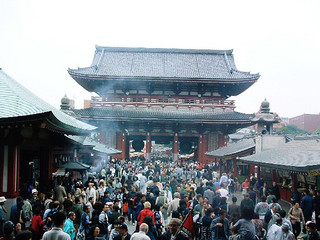Incense

- Japanese: 香 (kou), 線香 (senkou)
Incense features prominently in most East Asian societies. Though seen (smelled) in modern Japan chiefly in Buddhist contexts, where it serves a function of spiritual purification, incense was also burned for more non-religious, and even entertainment purposes, in earlier periods.
Incense came in a number of different forms, as it still does today, including sticks (senkô) and flat round "cakes." It was traditionally made from a variety of materials, including precious aromatic woods imported from China or Southeast Asia, such as aloeswood. One particularly famous piece of incense wood, known as the Ranjatai, has been kept in the Shôsôin imperial treasure house since the 8th century, and only on very rare occasions have pieces been permitted to be broken off and taken away as particularly prestigious gifts.[1]
Incense is traditionally burned for one's ancestors, both in Confucian/Chinese folk traditions, and in Buddhism. It was also traditionally burned in a variety of court ceremonies, and in personal private contexts, as part of ritual practices for spiritual merit.[2] The burning of incense is symbolically or metaphorically evocative of connection with the realms of spirits or deities, as it transforms visual, tangible, matter into "smoke that ascends into the invisible world."[3]
Incense was also burned in the pleasure quarters, and in certain other contexts, as a means of measuring time; in the Yoshiwara, courtesans often charged a customer by the "hour," by how many incense sticks had burned down during their time together.
Incense games or competitions, in which people would compete to identify or match smells, were a popular entertainment in the Imperial Court and other elite contexts. Though perhaps most strongly associated with the Heian period, as a result of works like the Tale of Genji which focus on the Court, incense games continued to be enjoyed amongst women of the court aristocracy well into the Edo period,[4] and were played by women in daimyô mansions in Edo as well, as late as the 1840s or 1850s.[5]
Incense in Ryukyu
As in China and Japan, incense was often burned traditionally in Ryûkyû as part of both Buddhist and non-Buddhist observances for the dead, as well as in court ceremonies and the like. Incense is also a prominent feature in worship practices in the native Ryukyuan religion.
Incense was also a common "gift" (or tribute) item given by the Ryûkyû Kingdom to the Tokugawa shogunate or to prominent figures associated with the shogunate. It came in a number of forms, including Daikan-kô 大官香, which came in long sticks, and was a local product of Ryûkyû; Jutai-kô 寿帯香, which came in thin white sticks, was said to repel snakes, and when burned produced ash in coils; and Ryûen-kô (Dragon Saliva Incense 龍涎香), which came in small, flat, round cakes roughly the size of a go stone, and which often had the characters for "longevity and fortune" (寿福) embossed into them.[6]
References
- ↑ Morgan Pitelka, Spectacular Accumulation, University of Hawaii Press (2016), 45-46, 183n14.
- ↑ Lee Butler, "Washing Off the Dust: Baths and Bathing in Late Medieval Japan," Monumenta Nipponica 60:1 (2005). pp1-41.
- ↑ Catherine Bell, "Performance," Critical Terms for Religious Studies.
- ↑ Cecilia Segawa Seigle, "Shinanomiya Tsuneko: Portrait of a Court Lady," in Anne Walthall (ed.), The Human Tradition in Modern Japan, Scholarly Resources, Inc. (2002), 3-24.
- ↑ Anne Walthall, "Nishimiya Hide: Turning Palace Arts into Marketable Skills," in Walthall (ed.), The Human Tradition in Modern Japan, Scholarly Resources, Inc. (2002), 45-60.
- ↑ Shirarezaru Ryûkyû shisetsu 知られざる琉球使節, Fukuyama-shi Tomonoura rekishi minzoku shiryôkan (2006), 150.